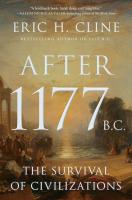
Princeton University Press (2024) h/b 352pp £28.00 (ISBN 9780691192130)
In the 12thC BC, hitherto interconnected civilizations in the Near East and eastern Mediterranean began to collapse like a house of cards. Caught in a perfect storm of earthquakes, disease, invaders and, yes, climate change resulting in drought and famine, not one of what C. calls the G8 (the Mycenaeans, Minoans, Hittites, Cypriots, Canaanites, Egyptians, Assyrians, and Babylonians) emerged unscathed, and scholars have labelled the ensuing centuries a Dark Age. Wrongly—or so C. argues in this brilliantly engaging and compelling volume, the sequel to his 2014 book, 1177 B.C.: The Year Civilization Collapsed (revised in 2021, and recently turned into a ‘graphic history’). Instead, he maintains, we should follow Hesiod and call this period much less pejoratively the Iron Age, a time of regrowth and inventiveness, which gave rise to ‘a set of ideas and cultures that ultimately resulted in the world to which we now belong.’
Arranging his examination by region rather than chronology, C. reaches a number of convincing conclusions, among them that the Hittites and Mycenaeans failed to survive the collapse because their previous apparent success masked inherent instability (Mycenae’s reliance on imports as well as its building programme of c. 1250, which included the Lion Gate and ‘Treasury of Atreus’ may have resulted in disastrous economic overreach and social disgruntlement); that politically fragmented Egypt lacked resilience; that Assyria and Babylon, despite initial robust leadership, eventually succumbed to pressures of crop failure and famine; and that the Phoenicians and Cypriots alone managed to adapt to the new circumstances, the latter being responsible for the shift from bronze to iron, the former for helping to create an alphabet so flexible that literacy boomed—though C. does not fully embrace the tantalizing suggestion that the Greek alphabet is considerably older than generally imagined, perhaps dating to the 11th century, and used to write documents on perishable materials which inevitably do not appear in the archaeological record.
Archaeology is at the heart of C.’s delve into this time of troubles, and intriguing details emerge: mummies, one with its throat slit, the other showing signs of strangulation, provide evidence for Pharaoh Ramses III’s assassination and the execution of his killer; a honey factory in Canaanite Rehov, home to bees imported from Anatolia 500 kilometres distant, speaks to the production of nearly 1,000 kilograms of honey and 100 kilograms of beeswax per annum; analysis of a ‘precisely dated speleothem record’ from a cave in north-eastern Iraq, shows how a major period of Assyrian imperial expansion coincided with the end of a drought that lasted from the late Bronze Age until around 925.
There are inevitable parallels with the modern world: C. was moved to write this book in part by a ‘sense of “future déjà vu”’, inspired among other things by a 2019 BBC radio report warning of ‘the possible collapse of our current civilization, courtesy of a multitude of interrelated factors ranging from climatic to economic’. Indeed, in his final chapter, C. sets his own research for the Iron Age against a 2012 United Nations’ Intergovernmental Panel on Climate Change special report entitled ‘Managing the Risks of Extreme Events and Disasters to Advance Climate Change Adaptation’. At all times, however, he is adamant that ‘blanket sweeping statements simply don’t work’, and part of what makes this book so powerfully engrossing is C.’s constant awareness of the fragile humanity of his subjects. No two societies reacted to the collapse in the same way. But all of them provide useful lessons.
This, then, is a remarkable and vital book, both a masterly overview of four centuries of history in which, following collapse, civilizations compelled by the realities of climate, natural disaster and war, in their own ways and at their own speeds adapted, transformed or simply went under, and perhaps a blueprint for our own future—though whether we succumb to the grim fate of Urartu, pillaged by the neo-Assyrian King Shalmaneser III in 858, its ‘defenders impaled on tall wooden stakes on the walls while the heads of others are nailed to the towers’, or surf the storm like the ingenious Cypriots, remains to be seen.
With 14 illustrations, 8 useful tables, a dramatis personae, excellent notes, an exhaustive bibliography, and index, After 1177 B.C.—well written in a clear, engaging, even witty style, using archaeology with sensitivity and lightness of touch—is a tour de force, heartily to be recommended to anyone interested not only in antiquity but in the present and potential future. Writing in its introduction, Barry Strauss, editor of the ‘Turning Points in Ancient History’ series to which this volume belongs, calls it a ‘bravura performance’. Cynics yet to read it might think, like Mandy Rice Davis, that he would say that, wouldn’t he. But by the time they’ve reached the final page they will find themselves in total agreement.
David Stuttard
